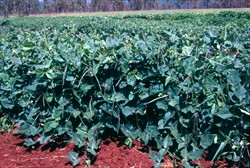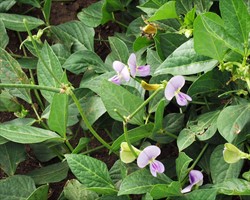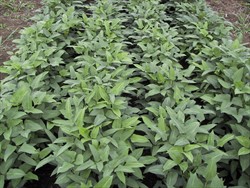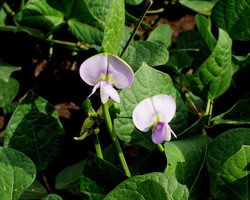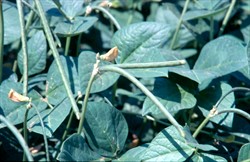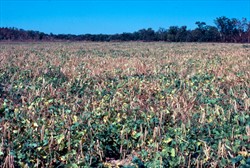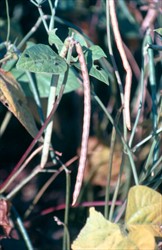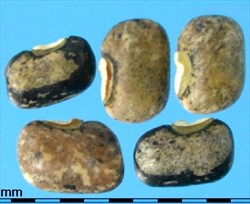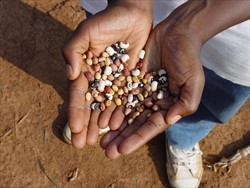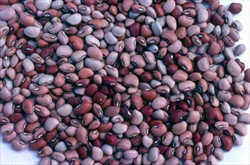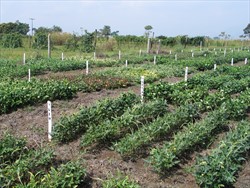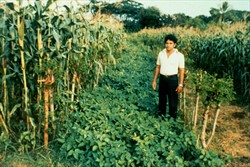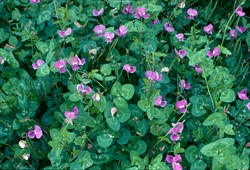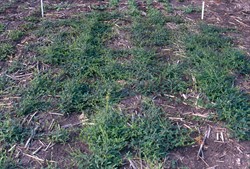Vigna unguiculata
Tropical Forages
Vigna unguiculata (L.) Walp.
Subordinate taxa:
The annual cultivated forms that comprise var. unguiculata have been divided into cultivar groups based mainly on pod, seed and ovule characteristics: gr. biflora; gr. melanophthalmus; gr. sesquipedalis; gr. unguiculata. Gr. textilis, a rare, primitive form with very long peduncles once used for fibre in Africa, has also been proposed but is not listed in GRIN. Vigna unguiculata (L.) Walp. subsp. unguiculata var. spontanea (Schweinf.) Pasquet is probably the progenitor of the species.
11 other subspecies of Vigna unguiculata (L.) Walp., all perennials, have been described: subsp. aduensis Pasquet; subsp. alba (G. Don) Pasquet; subsp. baoulensis (A. Chev.) Pasquet; subsp. burundiensis Pasquet; subsp. dekindtiana (Harms) Verdc.; subsp. letouzeyi Pasquet; subsp. pawekiae Pasquet; subsp. protracta (E. Mey.) B.J. Pienaar; subsp. pubescens (R. Wilczek) Pasquet; subsp. stenophylla (Harv.) Maréchal et al.; subsp. tenuis (E. Mey.) Maréchal et al.
Note: The main focus of this publication is subsp. unguiculata var. unguiculata.
Group biflora: Basionym: Phaseolus cylindricus L.; Dolichos biflorus L.; Dolichos catiang L.; Dolichos catjang Burm. f.; Vigna catjang (Burm. f.) Walp.; Vigna cylindrica (L.) Skeels; Vigna unguiculata subsp. cylindrica (L.) Verdc.
Group melanothalmus: Dolichos melanophthalmus DC.
Group sesquipedalis: Basionym: Dolichos sesquipedalis L.; Vigna sesquipedalis (L.) Fruwirth; Vigna sinensis subsp. sesquipedalis (L.) Van Eselt.; Vigna unguiculata subsp. sesquipedalis (L.) Verdc.
Group unguiculata: Basionym: Dolichos unguiculatus L.; Dolichos sinensis L.; Phaseolus unguiculatus (L.) Piper; Vigna sinensis (L.) Savi ex Hassk.
Note: These are the 4 main groups within var. unguiculata from which virtually all cultivated lines are drawn.
Family: Fabaceae (alt. Leguminosae) subfamily: Faboideae tribe: Phaseoleae subtribe: Phaseolinae subgenus: Vigna.
V. unguiculata is an extremely variable, climbing, trailing or more or less erect annual or perennial herb, growing 15‒90 cm high in a sward, or 2‒3 m for climbing forms. Stems 0.5‒5 m long, 0.5‒1 cm thick, hollow, largely glabrous, green, sometimes all purple, sometimes purple nodes only; adventitions roots formed along the stem. Leaves alternate, trifoliolate; petiole 5‒15 (‒25) cm long with distinct pulvinus; rachis (0.5–) 2.5–4.5 (–6.5) cm long; leaflets ovate, rhombic or lanceolate to linear, (1.5–) 7–14 (–20) cm × (1–) 4–10 (–17) cm, glabrous to pubescent; lateral leaflets asymmetrical, opposite; terminal leaflet symmetrical, entire, sometimes lobed; glabrous or slightly pubescent; stipules attached in the middle, upper part lanceolate, 6–20 mm long, spur narrower, 2–6 mm long. Flowering may be determinate or indeterminate, varying among genotypes. Inflorescence an axillary or terminal false raceme; peduncle 2‒35 cm long, flowers sequentially produced in alternating pairs on thickened nodes along an apical rachis, with cushion-like extra-floral nectaries between each pair of flowers. Flowers white, cream, yellow, mauve or purple; pedicel 1‒3 mm long; calyx tube c. 5 mm long, lobes narrowly triangular, c. 5 mm long; standard very broadly obovate, hood-shaped, 2‒3 cm long, wings obovate, c. 2 cm long, keel boat-shaped, c. 2 cm long Pods 8–30 (–120) cm long with 8‒30 seeds/pod. Seeds variable in size and shape, oblong to almost globose; variously coloured, including black, white, brown, maroon, cream and green; hilum oblong, 0.5–1 cm long, black, covered with a white tissue, with a blackish rim-like aril. Commonly 5,000‒20,000 seeds per kg.
1. Cultivated plant; pod >100 × 5 mm . . . . . . . . . . . . . . subsp. unguiculata var. unguiculata ....2
Plant wild or weedy; pod <100 × 5 mm . . . . . . . . . . . .var. spontanaea and other subspecies.
2. Flower and seed most often coloured; <17 ovules per ovary; pods not fleshy, unwrinkled, <30 cm, seeds not spaced within the pod; seed testa thick and shiny . . . . cv. gr. Biflora
Flower and seed often coloured; >17 ovules per ovary; pods fleshy, wrinkled when ripe, up to 1 m, seeds spaced within the pod; seeds reniform . . . . . . . . cv. gr. Sesquipedalis
Flower and seed partly white; < 7 ovules per ovary, pod not fleshy, unwrinkled, <30 cm, seeds not spaced within the pod; seed testa thin and often wrinkled . . . cv. gr. Melanophthalmus
Flower and seed often coloured; >17 ovules per ovary, pod not fleshy, <30 cm, seeds not spaced within the pod, testa thick and shiny . . . . . . . cv. gr. Unguiculata
Based on: http://keys.lucidcentral.org/keys/African_Vigna/Main/html/V.%20unguiculata%20Ecogeography.htm
By Cultivar Group
Vigna unguiculata: cowpea, Reeve's-pea, snake-bean (English); dolique de Chine (French); chiclayo (Spanish); ögonböna (Swedish); dongbu (Korean)
Group biflora: catjang, catjang cowpea, sow-pea (English); dolique mongette (French); feijão-fradinho (Portuguese); judía catjang (Spanish); mei dou (Chinese)
Group sesquipedalis: asparagus-bean, Chinese long-bean, pea-bean, yard-long-bean (English); lobiya (Arabic); dolique asperge, haricot asperge (French); Spargelbohne (German); feijão-espargo (Portuguese); judía espárrago (Spanish); chang jiang dou (Chinese)
Group unguiculata: black-eyed-pea, cowpea, crowder-pea, southern-pea (English); haricot indigène, niébé, pois à vaches (French); Augenbohne (German); fagiolino dall'occhio, vigna cinese (Italian); sasage (Japanese); costeño, frijol de costa, rabiza (Spanish); jiang dou (Chinese)
By country/language
Africa: akkerboon, boontjie, dopboontjie, kaffer boontjie, koertjie, swartbekboon (Afrikaans); omakunde, olunya, omandume, ongoli (Angola & Namibia, Oshiwambo); lubia hilo, lûbyâ' baladî, mâsh, (Arabic); ayiman, yiviman (Benin, Aizo); atchakobo, guisei (Benin, Anii); blaa (Benin & Nigeria, Boko); ayiman (Benin, Cotafon & Fon); dinawa, nyeru, dinawa, morogo wa dinawa (Botswana, Setswana); titukpindi, toutoufari (Burkina Faso-Niger, Gourmanché); kon, kondi (Cameroon); adanguari, adenguare, nori (Ethiopia, Amharic); adua, ayi, too, tipielega, yo, tuya, saau (Ghana); thoroko (Kenya, Kikuyu); tsafe (Kenya, Giriama); dinawa, monawa (Lesotho, N Sotho); linaoa (Lesotho, Sesotho); soso (Mali, The Gambia); fûl gnâwa (Morocco, Arabic); khobwe (Mozambique-Zambia, Chichewa); ayiman (Niger, Adja); akedi, ako, alev, arebe, azzo, dijok, ewa, ezo, lubia, mongo, nyebbe, ngalo, ti, wake (Nigeria); suiwurusu (Nigeria, Bariba); niao, seub (Senegal); luba hilu (Sudan); nkunde (Tanzania, Nyiha); kedesche, sona, kadje, tombing, isanje (Togo); boo, enkoole, ngor (Uganda, Acholi); amuli, obo (Uganda, Alur & Jonam); likote (Uganda, Bugisu); laputu, nyele (Uganda, Kakwa); maruet “wild” (Uganda, Karamajong); eggobe, mpindi (Uganda, Langi); bojo, kiyindiru (Uganda, Luganda); enkoole omugobe (Uganda, Runyankore); omugobe (Uganda, Runyoro); omugobe (Uganda, Rutooro); lmere, eboo (Uganda, Teso); ewa, wake (West Africa); nyemba (Zimbabwe, Shona); imbumba, indumba, isihlumaya (Zulu)
Asian: 豇豆 jiang dou, 原亚种 yuan ya zhong (Chinese); kacang béngkok, kacang bol, kacang merah, kacang perut ayam, kacang toonggak, kacang tunggak, kacang panjang (Indonesia); hachigawa, juroku sasage, sasage (Japanese); sândaêk kâng, sândaèk ângkuy, sândaèk kâng, sândaèk khmau, sândaèk krâhâm, sândaèk sâ, sândaèk troeung (Khmer); tongpu (Korean); thwàx do, thwàx siênx (Lao); kachang bol (Malaysia); batong, otong, kibal (Philippines, Bisayan), sitaw-turo, paayap (Philippines, Tagalog); Вигна китайская vigna kitaiskaia (Russian); po-thoh-saa, thua khaao, thua rai, tua dam, tua fak yaow, tua phnom (Thai); börülce (Turkish); đậu bò, đậu dải, đậu dải trắng rốn nâu, đậu đũa, đậu hôềng đáo,đậu măắt cua, đậu trăắng, dôu den, dôu tua, hoàng đáo (Vietnamese)
English: bachapin bean, beans, black-eye bean, cowpea, crowder pea, Kaffir pea, macassar bean, marble pea, rope bean, southern pea
Europe: vignabønne, koaert (Danish); kouseband (Dutch); dolique asperge, dolique à oeil noir, dolique mongette, haricot asperge, haricot indigène, niébé, pois à oeil noir, pois à vaches (French); Augenbohne, Kuhbohne, Kuherbse, Langbohne (German); fagiolino piccolo, fagiolo dall'occhio nero (Italian); feijão-espargo, feijão-frade, feijão-fradinho (Portuguese); costeño, frijol de costa, judía catjang, judía espárrago, rabiza (Spanish); carilla, carillas, caritas, cerigüellos, cerigüelos, cirigüellos, cirigüelos, Dolico Esparrago, habichuelas de a metro, iuelas, judía, judía carilla, judía de careta, judía de vaca, luelas, muchachinos con chaleco (Spanish, Castillano); banyolí, caragirat, escorxatites, fesol menut, fesol menut/fesols menuts, fesoler, fesoler menut, fesolera, fesolet, fesolets, guixó, guixonera, monget (Spanish, Catalan); guixonera, guixóns (Spanish, Majorcan); vignaböna (Swedish)
Indian Ocean: antaka, avokondrana, lozy, mahalaindolo, voahimba, voanemba, voatsirokonangatra (Madagascar); voehme (Mauritius, Creole); brenm (Seychelles, Creole)
South Asia: barboti kolai, ghangra (Bengali); chola, chowla (Gujarati); चवली की फली, bora, bura, chawli, kulathi, kurathi, लोबिया lobia, lobhia, lobiya (Hindi); alasabde, alasande, alasundi (Kannada); payar, vellapayar (Malayalam); alasunda, chavali, chavli (Marathi); bargada, chani, jhudunga (Oriya); raung (Punjabi); mahamasah, rajamasah (Sanskrit); me-karak (Sinhala); kaattu ulundu, karamani (Tamil); alasandalu, bobbarlu, kaaraamanulu (Telugu); lathanae, lattane (Tulu); kulthi (Urdu)
Latin America: ervilha do vacs, fava de vaca, feijão carito, feijão de China, feijão de corda, feijão Macasar, feijão-miúdo, vigna (Portuguese); arveja de vaca, caupi, chicharo de vaca, frejol, frijol Castilla, fríjol de cuerno, frijol precioso, gaupi, guisante de vaca, lentejas, poroto, rabiza (Spanish); poroto tape, poroto arroz, porotito del ojo (Argentina); fríjol de cabecita negra, fríjol caritas (Colombia); frijol alacin (Nicaragua); frijol ojo negro (Panama); frijol Castilla, chiclayo (Peru)
Note: There are between 1,250 and 2,100 languages spoken in Africa and more with dialects, each with one or more names for Vigna unguiculata. This is only a cross-section of those names, and does not represent their relative importance. There are also many more names used in the Asian sub-continent.
Native:
Africa: Angola; Benin; Botswana; Burundi; Cameroon; Central African Republic; Côte d'Ivoire; Democratic Republic of the Congo; Ethiopia; Gabon; Ghana; Guinea; Kenya; Liberia; Mozambique; Namibia; Nigeria; Rwanda; Senegal; Sierra Leone; South Africa (Eastern Cape, Free State, Gauteng, KwaZulu-Natal, Limpopo, Mpumalanga, North West); Sudan; Swaziland; Tanzania; Togo; Zambia; Zimbabwe
West Africa, where the highest genetic diversity and the most primitive forms of wild V. unguiculata occur, was probably the primary centre of domestication.
Cultivated:
Cowpea is cultivated throughout the tropics and subtropics between 35º N and 30ºS , across Asia and Oceania, the Middle East, southern Europe, Africa, southern USA, and Central and South America.
Vigna unguiculata is a multi-purpose species, used for human and animal consumption, and for soil maintenance and improvement, and is one of the most widely used legumes in the tropical world. There are three types according to their uses: for grain, forage or dual-purpose.
Forage
The various cultivars selected specifically for feeding livestock can be fed fresh cut-and-carry forage or grazed, and/or preserved as hay or silage. Cowpea hay is equivalent in feeding value to the industry standard, alfalfa/lucerne (Medicago sativa). Haulms remaining after pod/seed production are largely fed to livestock. Excellent hay, and particularly silage, can be made by harvesting a mixed crop of cowpea and forage sorghum or millet.
The potential of the perennial subspecies in livestock production systems may not have been adequately investigated, e.g. V. unguiculata subsp. dekindtiana accessions have been evaluated for use as ley pastures on alkaline clay soils in southern Queensland, producing DM yields up to 6 t/ha in the first year, which matches yields of other well-adapted legumes. However, plants did not survive the winter and there was little seedling regeneration in the second year at all sites. These subspecies should be further tested in different environments where they may provide an alternative to species such as late flowering var. unguiculata cultivars or Lablab purpureus, or short-term phase legumes such as Macroptilium bracteatum or Clitoria ternatea that survive for 2‒3 years.
Environment
V. unguiculata is excellent as a cover crop between different crops in rotation and as a green manure. Estimates of fixed nitrogen from cowpea often range from about 50 to in excess of 100 kg/ha N. It can be incorporated into the soil or spread on the soil surface 8‒10 weeks after sowing. When cowpea is used as a green manure, grain yields from a subsequent maize crop can be doubled compared to unfertilized crops.
Other
Leaves and flowers are used as vegetables in some cultures, and the grain provides a protein-rich staple. As with a number of other Vigna spp., cowpea is deemed to have a range of medicinal benefits in various cultures.
Soil requirements
Adapted to a wide range of soils from sands to heavy, well-drained clays, with a preference for lighter soils that facilitate good root development. Wide range of pH including very acid (pH 4), low-fertility soils. Better adapted to strongly acid soils than either Lablab purpureus or Mucuna pruriens. Grows well also on heavy textured strongly alkaline soils. Does not tolerate salinity, vegetative growth being reduced by 9.0% for each unit increase in electrical conductivity of the soil saturation extract beyond a threshold value of 1.6 dS/m and dry seed yield by 12% for each unit increase beyond 4.9 dS/m.
Moisture
Moderately tolerant of drought but excessive soil moisture is harmful, reducing growth and favouring infection by fungal diseases. Nevertheless, V. unguiculata is well adapted to a wide precipitation range (650‒2,000 mm). For forage, annual rainfall regimes of 750‒1,100 mm are preferable. As a food crop for humans, often grown in annual rainfall regimes as low as 400 mm. Extended water logging or poor drainage should be avoided. Does not tolerate extended flooding.
Temperature
Grows from sea level up to 1,500 m asl, depending on latitude. Very susceptible to frost; grows well only in warm seasons with 25‒35 °C as optimum temperature. Growth is markedly reduced when temperatures fall below 15 °C, and most cowpea varieties do not flower at all if the average temperature falls below 8 °C.
Light
Moderate shade tolerance.
Reproductive development
The different cowpea accessions can show wide variation in reproductive development. Some may start flowering 30 days after sowing and are ready for harvest of dry seeds 25 days later; others may take more than 90 days to flower, and 210‒240 days to mature. Many cultivars mature uniformly although there are determinate and indeterminate genotypes. Some of the indeterminate types have the potential to produce multiple flushes of flowers during a season. These are particularly useful in smallholder farming systems where a supply of fresh leaves and flowers over an extended period of time enables a sustained supply of vegetables for the household. Determinate types are better for machine harvesting. Cowpea is mostly a quantitative short-day plant, but there are also day-neutral cultivars. Planting out of season or taking seed of photoperiod sensitive genotypes to different latitudes, may inhibit seed set. Most cultivated cowpeas and the subspecies alba, dekindtiana, pubescens, stenophylla and tenuis, together with var. spontanea, are highly self-pollinated, their anthers usually being in contact with the surfac of the stigma. Subspecies aduensis, baoulensis, burundiensis, letouzeyi and pawekiae are all out-crossing, their anthers lying below the surface of the stigma and the stigmatic surface directed upwards with its lower part protected by a beard of long hairs.
Defoliation
When seasons are suitable and when sown relatively early, the best forage types will regrow after grazing. Grazing should be light to ensure that the plant frame with numerous growing points is retained and damage is limited.
Fire
Not tolerant of fire.
Guidelines for establishment and management of sown forages.
Establishment
There is no dormancy in cultivated cowpea seeds, so they can be planted immediately after harvest of the first crop. A daytime temperature of 25 ° C or above, and a consistent soil temperature of at least 18 °C are best for establishment. Sowing arrangement according to intended use: for fodder and green manure, 30‒60 cm between rows and 10‒15 cm between plants are suitable; required seeding rate about 20 kg/ha. Other seeding rates reported are 10‒40 kg/ha when sown in rows and up to 90 kg/ha when broadcast. Most common 20‒50 kg/ha. Sowing depth 3‒5 cm. Seed is soft so germination is usually rapid if moisture and temperature are adequate. Promiscuous in its rhizobial requirements. V. unguiculata subsp. dekindtiana usually has a high proportion of hard seed, and may need scarification prior to sowing.
Fertilizer
Responses have been recorded to P, K and S as well as molybdenum on poor fertility soils.
Compatibility (with other species)
Grows well in association with cereal crops through intercropping.
Companion species
Is widely used in intercropping of the major African cereals, maize (Zea mays), sorghum (Sorghum bicolor) and millet (Cenchrus americanus).
Pests and diseases
Cowpea is susceptible to a wide range of diseases and pests (including post-harvest), particularly those attacking the grain. The major fungal diseases are anthracnose caused by Colletotrichum lindemuthianum, web blight caused by Rhizoctonia solani , brown blotch caused by Colletotrichum capsici, Cercospora leaf spot caused by Pseudocercospora cruenta and Cercospora apii s. lat., Septoria leaf spot caused by Septoria vignae, scab caused by Sphaceloma spp. and charcoal rot caused by
Ability to spread
Commercial cowpeas are soft seeded annuals and have little potential for survival in the soil. Hard-seeded perennial subspecies may have some potential to spread but have not been evaluated as forages to any extent.
Weed potential
None.
Nutritive value
High nutritive value: CP in green foliage 14‒21% and in crop residues 6‒8%, in grain 18‒26%; IVDMD of foliage >80%. IVDMD of residues after grain harvest 55‒65%.
Palatability/acceptability
Very palatable, high intake.
Toxicity
None for ruminants; for monogastrics, trypsin inhibitors and some content of tannin need to be taken into account. 20‒25% of grain in diet fed without treatment seems not to pose a problem. Heat treatment reduces trypsin inhibitors. Cowpea poses a low bloat risk to cattle.
Feedipedia links
https://www.feedipedia.org/node/232 (Seeds)
https://www.feedipedia.org/node/233 (Forage)
Dry matter
Vegetative DM production 3‒10 t/ha in 8‒12 weeks; grain production 250‒4,000 kg/ha.
Animal production
Very few studies available; when fed as supplement, 10‒20% increase in milk yield (Colombia) and 50% higher animal LWG (67 g/day with sheep) are reported (West Africa).
2n = 22; most cultivated cowpeas (var. unguiculata) and the subspecies alba, dekindtiana, pubescens, stenophylla and tenuis (and var. spontanea) are highly self-pollinated. The subspecies aduensis, baoulensis, burundiensis, letouzeyi and pawekiae are all outcrossing. The outcrossing group of subspecies are not readily crossed with the fairly closely selfed var. unguiculata cultivars, while some subspecies from the selfing group of subspecies are more easily crossed with the cultivated cowpea. Cowpea genetic improvement activities aim at development of lines that address yield and quality issues, which includes overcoming the various abiotic and biotic stresses that adversely affect productivity. Molecular genetic tools are being increasingly used in cowpea improvement programs to incorporate desirable traits such as resistance to Striga, Macrophomina, Fusarium wilt, bacterial blight, root-knot nematodes, aphids, and foliar thrips into previously susceptible varieties.
Large variation in seed production depending on cultigroup, landrace and use. Seed yields from 1,000 to 4,000 kg/ha are achievable in well-managed monocrops, but in mixed cropping systems with maize, sorghum, or millet, and without insecticides, yields of 100 to 300 kg/ha seed are more likely.
At least two weedings within the first 5 weeks after sowing are necessary to minimize yield reduction caused by weeds in cowpea. Most annual grasses can be effectively controlled by preemergence application of metolachlor at 2.0 to 3.0 kg/ha, DCPA at 10.0 kg/ha, or pendimethalin at 2.0‒2.5 kg/ha, with little or no adverse effect to the crop. However, the common annual weed, itchgrass (Rottboellia cochinchinensis), which can be controlled with pendimethalin at 2.5 kg/ha, is not controlled with metolachlor. Preemergence application of alachlor at 2.0 kg/ha is effective against annual weeds, but damaging to cowpea. In Australia, the only herbicide registered for preemergence control of annual grasses and some broadleaf weeds in cowpea is trifluralin. Cowpeas are highly sensitive to hormone herbicides and dicamba.
- Multi purpose legume providing leaf, grain and forage.
- Improves soil fertility .
- Ease of establishment.
- Very high nutritive value and high palatability.
- Adapted to a wide range of soils.
- Better adapted to acid soils than other green manure crops.
- Drought tolerant.
- High yields in a short period of time.
- High seed production.
- Intolerant of waterlogging and flooding.
- Pest and disease susceptibility.
- Host for pests of Phaseolus beans.
Boukar, O., Belko, N., Chamarthi, S., Togola, A., Batieno, J., Owusu, E., Haruna, M., Diallo, S., Umar, M.L., Olufajo, O. and Fatokun, C. (2018) Cowpea (Vigna unguiculata): Genetics, genomics and breeding. Plant Breeding 138:415–424. doi.org/10.1111/pbr.12589
Eaglesham, A.R.J., Ayanda, A., Randa Rao, V. and Eskew, D.L. (1982) Mineral N effects on cowpea and soybean crops in a Nigerian soil. II. Amounts of N fixed and accrual to the soil. Plant and Soil 68:183–192. doi.org/10.1007/BF02373704
Fatokun, C.A., Tarawali, S.A., Singh, B.B., Kormawa, P.M. and Tamò, M. (eds) (2002) Challenges and opportunities for enhancing sustainable cowpea production. International Institute of Tropical Agriculture (IITA), Ibadan, Nigeria. bit.ly/3dSdtFi
Fery, R.L. (2002) New opportunities in Vigna. In: Janick, J. and Whipkey, A. (eds) Trends in new crops and new uses. ASHS Press, Alexandria, VA, USA. p. 424–428. hort.purdue.edu/newcrop/ncnu02/v5-424.html
Imrie, B. (2004) Cowpea. In: Hyde, K. (ed) The New Rural Industries. A handbook for Farmers and Investors. Rural Industries Research and Development Corporation, Canberra, Australia.
Kamara, A.Y., Chikoye, D., Ekeleme, F., Omoigui, L.O. and Dugje, I.Y. (2008) Field performance of improved cowpea varieties under conditions of natural infestation by the parasitic weed Striga gesnerioides. International Journal of Pest Management 54:189–195. doi.org/10.1080/09670870801930260
OECD. (2016) Safety assessment of transgenic organisms in the environment, Volume 6. OECD Consensus Documents, OECD Publishing, Paris, France. doi.org/10.1787/9789264253421-8-en
Pandey, R.K. and Westphal, E. (1989) Vigna unguiculata (L.) Walp. In: van der Maesen, L.J.G. and Somaatmadja, S. (eds) Plant Resources of South-East Asia No. 1. Pulses. Pudoc Scientific Publishers, Wageningen, the Netherlands. p. 77–81. edepot.wur.nl/281901
Pasquet, R.S. (1998) Morphological study of cultivated cowpea Vigna unguiculata (L.) Walp. Importance of ovule number and definition of cv. gr Melanophthalmus. Agronomie 18:61–70. doi.org/10.1051/agro:19980104
Pasquet, R.S. (1999) Genetic relationships among subspecies of Vigna unguiculata (L.) Walp. based on allozyme variation. Theoretical and Applied Genetics 98:1104–1119. doi.org/10.1007/s001220051174
Peters, M., Franco, L.H., Schmidt, A. and Hincapié, B. (2003) Especies forrajeras multipropósito: Opciones para productores de Centroamérica. Centro Internacional de Agricultura Tropical (CIAT), Cali, Colombia. hdl.handle.net/10568/54681
Schlecht, E., Mahler, F., Sangaré, M., Susenbeth, A. and Becker, K. (1995) Quantitative and qualitative estimation of nutrient intake and faecal excretion of Zebu cattle grazing natural pasture in semiarid Mali. In: Powell, J.M., Fernández–Rivera, S., Williams, T.O. and Renard, C. (eds) Livestock and sustainable nutrient cycling in mixed farming systems of sub-Saharan Africa. Proceedings of an International Conference. Addis Ababa, Ethiopia, 22–26 November 1993. p. 85–97. hdl.handle.net/10568/401
Singh, B.B. (2014) Cowpea: The Food Legume of the 21st Century. CSSA, Madison, WI, USA. doi.org/10.2135/2014.cowpea.frontmatter
Singh, B.B. and Tarawali, S.A. (1997) Cowpea and its improvement: key to sustainable mixed crop-livestock farming systems in West Africa. In: Renard, C. (ed) Crop residues in sustainable mixed crop-livestock farming systems. International Crops Research Institute for the Semiarid Tropics (ICRISAT), International Livestock Research Institute (ILRI), and CAB International, Wallingford, UK. p. 79–100. oar.icrisat.org/1046/1/RA_000315.pdf#page=94
Singh, B.B., Mohan Raj, D.R., Dashiell, K.E. and Jackai, L.E.N. (eds). (1997) Advances in cowpea research. International Institute of Tropical Agriculture (IITA) and Japan International Research Center for Agricultural Sciences (JIRCAS), Ibadan, Nigeria. bit.ly/2wQ0ljtCultivars have been selected or developed in many countries around the tropics according to the needs of the community, but these are far too numerous to list in this publication.
Selection criteria include:
- application - grain yield, forage yield, dual purpose, green manure, intercropping
- system - irrigated/non-irrigated
- disease tolerance - phytophthora stem rot
- pest tolerance - resistance to root knot nematodes and Striga
IT90K-284/2, IT89KD-391, IT95K-1088/4, IT95K-1088/2, IT86D-716, IT93K-637/1, FHIA 9611, CIDICCO 2. Selected in Colombia, Costa Rica, Honduras and Nicaragua for broad adaptation, herbage and grain yield and green manure effects.
IT93KZ-4-5-6-1-6. Selected in Abomey plateau of southern Benin for resistance to Striga gesnerioides where local cowpea varieties are highly susceptible.
IT97K-499-35 (semi-erect, determinate). Selected in the northern Guinea Savanna of Nigeria and in the Sudan savanna for resistance to Striga gesnerioides.
CPI 121688 (subsp. dekindtiana). Selected in Australia. Origin near Serule, Botswana (22º S, 1,200 m asl, rainfall 400mm). Tested on a range of clay soils in the subtropics with first year yields comparable with many other well-adapted legumes, even in very dry years.
